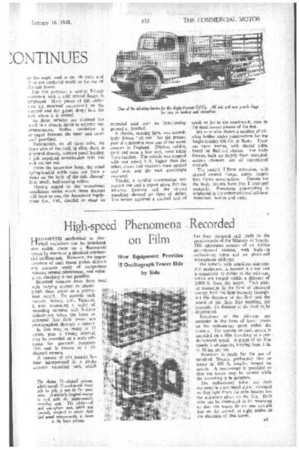High-speed Phenomena -Recorded on Film
Page 37

If you've noticed an error in this article please click here to report it so we can fix it.
New Equipment Provides IS Oscillograph Traces Side by Side
HIGH-SPEED mechanical or electrical variations can be translated into visible traces on a fluorescent screen by means of a standard commercial oscillograph. However, the impermanence of such traces makes difficult any accurate study of comparison between several phenomena, and subsequent checking is not possible.
Standard cameras have been used with varying success to photograph these traces as a permanent record. To provide such records, Avimo, Ltd., _Taunton, is now producing a series of recording cameras with built-in cathode-ray tubes, the latter "so arranged that their traces are photographed through a mirror.
In this way, as many as 15 traces, plus a timing interval, may be recorded on a scale adequate for practical purposes. This unit is known as a 15channel camera.
A camera of this pattern has been incorporated in a photo acoustic recording unit, which has been designed and made to the requirements of the Ministry of Supply. This apparatus consists of an Avirno six channel camera, with built in cathode-ray tubes and six photo-cell microphone pick-ups.
The camera, with amplifiers and control equipment, is housed in a van and is connected by cables to the pick-ups, which are ranged within a distance of 2,000 ft. from the target. Each pickup transmits, in the form of electrical energy, both the light intensity throughout the duration of the flash and the sound of the flash thus enabling, for example, the distance of theflash to be . , , determined.
Reactions of the pick-ups are recorded in the form of linear traces on the cathode-ray tubes within the camera. The tracing on each screen is Kecorded on a film travelling at a predetermined speed. A range of six film speeds is obtainable, varying from 1 in. to 50 ins, per sec.
Provision is made for the use of standard 70-mm. perforated film or paper in 100 ft. lengths, wound on spools. A microscope is provided so that the traces may be viewed while the recording is in progress.
The cathode-ray , tubes are each mounted in a mu-metal shield, arranged so that light from the tube heaters has the minimum effect on the film. Each tube can be orientated in its mounting so that the traces lie 'on one straight line on the record, at right angles to the direction of film travel.












































































